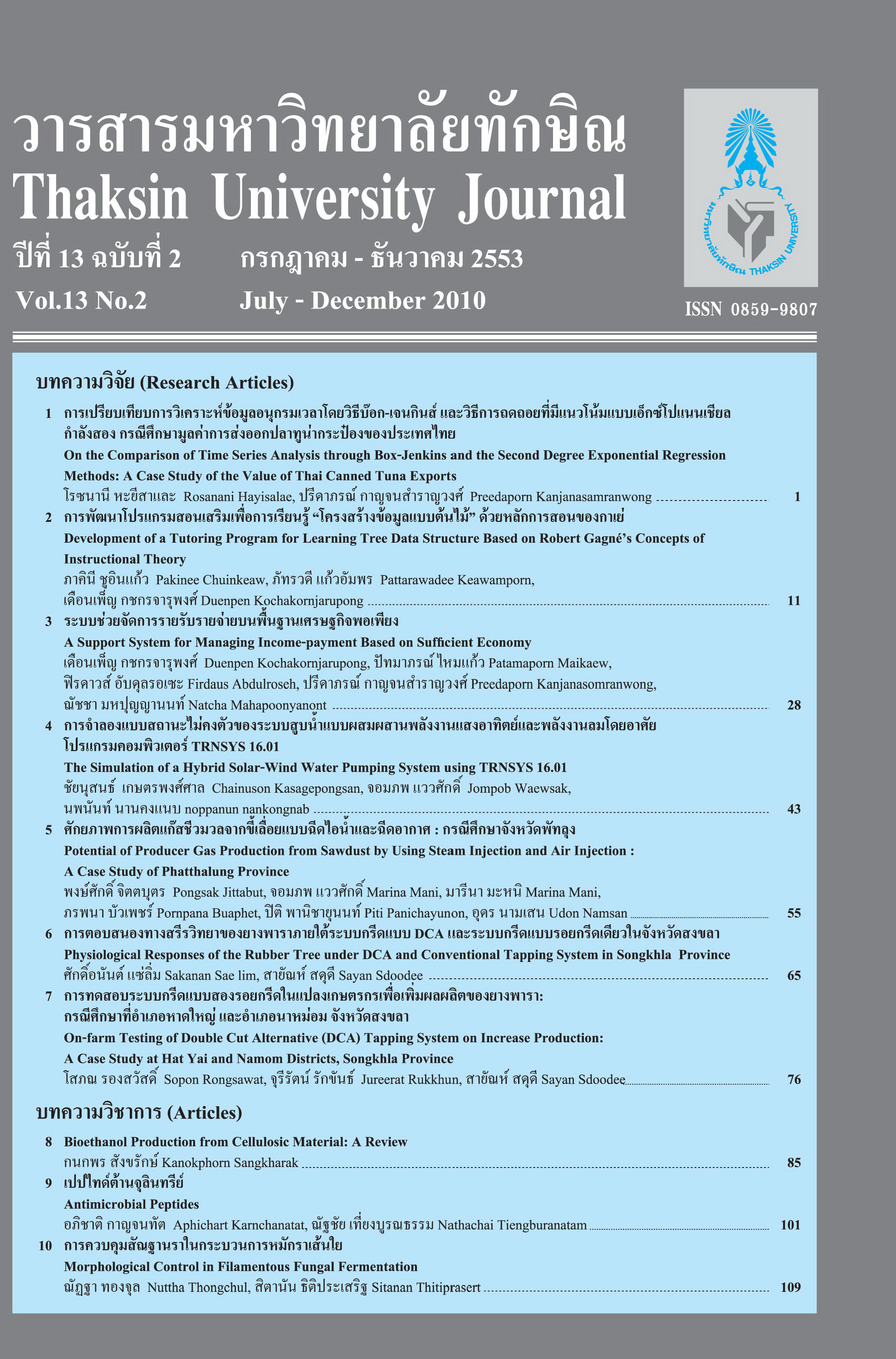ศักยภาพการผลิตแก๊สชีวมวลจากขี้เลื่อยแบบฉีดไอน้ำและฉีดอากาศ : กรณีศึกษาจังหวัดพัทลุง
Main Article Content
Abstract
งานวิจัยนี้มีวัตถุประสงค์เพื่อศึกษาศักยภาพทางพลังงานของขี้เลื่อยในจังหวัดพัทลุงและองค์ประกอบของแก๊ส ชีวมวลที่ได้จากการจำลองแบบและจากการทดลองเพื่อเปรียบเทียบผล ซึ่งแก๊สชีวมวลที่ได้จากกระบวนการผลิตแก๊ส ชีวมวลสามารถนำไปเดินเครื่องยนต์แก๊สได้โดยตรง สามารถนำแก๊สที่ได้ไปเป็นเชื้อเพลิงประกอบอาหาร และยังเป็นมิตร กับสิ่งแวดล้อมมากกว่าการผลิตไฟฟ้าจากเชื้อเพลิงฟอสซิล จากแผนที่ศักยภาพทางพลังงานของขี้เลื่อยในจังหวัดพัทลุง พบว่าอำเภอเมืองมีศักยภาพทางพลังงานของขี้เลื่อยสูงสุดประมาณ 97,667 ตัน/ปี รองลงมาได้แก่อำเภอควนขนุน ประมาณ 79,975 ตัน/ปี และอำเภอเขาชัยสนประมาณ 7,169 ตัน/ปี ตามลำดับ ซึ่งเป็นพื้นที่ที่เหมาะสำหรับการติดตั้งระบบ ผลิตแก๊สชีวมวล เพื่อลดค่าใช้จ่ายในการขนส่งเชื้อเพลิงขี้เลื่อย ผลการวิเคราะห์โดยประมาณของขี้เลื่อยมีค่าปริมาณสาร ระเหยที่เผาไหม้ได้ 65.9% โดยปริมาณคาร์บอนคงตัวมีค่าเท่ากับ 15.6% และปริมาณเถ้า 1.5% ที่ค่าความชื้น 17.0% ตามลำดับ ส่วนผลการวิเคราะห์แบบแยกธาตุของขี้เลื่อยมีคาร์บอน 46.4% ไฮโดรเจน 7.1% ออกซิเจน 44.8% ไนโตรเจน 0.33% ซัลเฟอร์ 0.03% ตามลำดับ สูตรทางเคมีของขี้เลื่อยคือ CH1.83O0.72 ผลจากแบบจำลองทางคณิตศาสตร์ของ ระบบผลิตแก๊สซิไฟเออร์ชนิดเบดหยุดนิ่ง พบว่าในกรณีที่ฉีดอากาศและกรณีที่ฉีดไอน้ำแก๊สชีวมวลมีองค์ประกอบดังนี้ คาร์บอนมอนออกไซด์ 9-36%Vol. คาร์บอนไดออกไซด์ 0-21%Vol. มีเทน 1-4%Vol. และไฮโดรเจน 7-32%Vol. ค่าความ ร้อนสูงของแก๊สชีวมวลมีค่าอยู่ในช่วง 4.6-8.8 MJ/Nm3 และ ประสิทธิภาพของระบบผลิตแก๊สชีวมวลเท่ากับ 69-90% นอกจากนี้ยังได้มีการศึกษาเปรียบเทียบโดยทำการทดลองเดินระบบผลิตแก๊สซิไฟเออร์ชนิดเบดหยุดนิ่งเปลวไฟไหลลงในกรณีฉีดอากาศและฉีดไอน้ำในช่วงอุณหภูมิ 100-800oC โดยใช้ขี้เลื่อยเป็นเชื้อเพลิงพบว่าในกรณีที่ฉีดอากาศและกรณี ที่ฉีดไอน้ำแก๊สชีวมวลจะมีองค์ประกอบดังนี้ คาร์บอนมอนออกไซด์ 8-32%Vol. คาร์บอนไดออกไซด์ 9-22%Vol. มีเทน 2-4.6%Vol. และไฮโดรเจน 6-33%Vol. ค่าความร้อนสูงของแก๊สชีวมวลมีค่าอยู่ในช่วง 6.9-12.0 MJ/Nm3 โดยมีประสิทธิ ภาพของระบบผลิตแก๊สชีวมวลเท่ากับ 64-75% ซึ่งทั้งสองกรณีสูงพอสำหรับการเดินเครื่องยนต์แก๊สเพื่อการผลิตไฟฟ้า
The main objective of this research is to study the energy potential of the sawdust and producer gas production by using steam and air injections. The energy potential map of sawdust revealed that Muang district was the highest potential sawdust resource approx 97,667 ton/year. The second was Khuankanon district approx 79,975 ton/year. In addition, Muang, Khao Chai Son and Khao Chai Son districts were the high potential sawdust resources approx 7,169 ton/year. Results by proximate analysis showed that the contents of compounds in sawdust are of follows; VM 65.9%, the FC was the same as 15.6% and AC 17.1% and 1.5% at the MC of 17.0% respectively. Results by ultimate analysis indicated that sawdust were composed of C 46.4%, H 7.1%, O 44.8%, N 0.12% and S 0.03% respectively corresponding to the chemical formula of sawdust was CH1.83O0.72. The simulation of a fixed bed gasifier was accomplished using the stationary model developed by S. A. Klien and F. L. Alvarado. Results showed that using the air as an agent, CO was 9-35%Vol., CO2 was 0-21%Vol., CH4 was 1-4%Vol., and H2 was 7-31%Vol. The high heating value was in the range of 4.6-8.7 MJ/Nm3 and the gasification efficiency was 69-88%. While using the steam as agent, CO was 10-36%Vol., CO2 was 0-21%Vol., CH4 was 1-4%Vol., and H2 was 9-32%Vol. The high heating value was in the range of 4.8-8.8 MJ/Nm3 and the gasification efficiency was 72-90%. And The composition and heating value of product gas operated with/without steam injection condition were investigated based on experimentation. The operating temperature varied in the range of 100-800oC. Experimental results showed that the gas composition was composed of CO approx 8-32%Vol., CO2 approx 9-22%Vol., H2 approx 6-33%, CH4 approx 2-5%. The high heating value of product gas with/without steam injection was 6.9-8.6 MJ/Nm3 and 10.8-12 MJ/Nm3. The gasification efficiency was 64-75%. Finally, the use of either air or steam as an agent could produce the product gas which composed sufficient combustible gases for internal combustion engine in the power generation.


